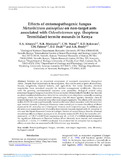Effects of entomopathogenic fungus Metarhizium anisopliae on non-target ants associated with Odontotermes spp. (Isoptera: Termitidae) termite mounds in Kenya

View/
Date
2016Author
Abonyo, E.A.
Maniania, N.K.
Warui, Charles M.
Kokwaro, E.D.
Palmer, T.M.
Doak, D.F.
Brody, A.K.
Metadata
Show full item recordAbstract
Termites are an important component of savannah ecosystems throughout Africa. Despite their importance in the ecosystem, they can be serious pests of structures, houses, rangelands, tropical forestry, and agriculture. For many decades, chemical insecticides have remained popular for termite management worldwide. However, with the growing environmental concerns over pesticides, biological control using entomopathogenic fungi such as Metarhizium anisopliae (Metschnikoff) Sorokin has become an often-considered alternative. Metarhizium anisopliaeis an ubiquitous, naturally occurring pathogen, which has been reported infecting over 200 insect species; therefore, there is concern that use of M. anisopliae may affect non-target organisms. The effects of M. anisopliae isolate ICIPE 30 were experimentally tested on the ants which associate with Odontotermes spp. termite mounds. Laboratory bioassays were carried out to assess the effects of direct exposure to M. anisopliae on Crematogaster mimosae and Camponotus spp. In addition, ant diversity was monitored over 18 months from termite mounds treated with M. anisopliae in situ near the Mpala Research Centre in Laikipia District of central Kenya. Results obtained revealed no effects of direct exposure to M. anisopliae isolate ICIPE 30 on the mortality of C. mimosae (F1 = 7.29, P = 0.0072) or Camponotus spp. (F1 = 13.01, P = 0.0004) in the laboratory. No significant difference in Shannon indices of ant diversity from treated and untreated mounds (F1 = 0.016, P = 0.8989) was found. It is evident that M. anisopliae has no negative effects on ants that are associated with Odontotermes spp. termites
URI
http://thepalmerlab.com/TMP/publications_files/Abonyo%20et%20al.%202016.pdfhttp://hdl.handle.net/123456789/2984
Collections
- Journal Articles (PAS) [289]
